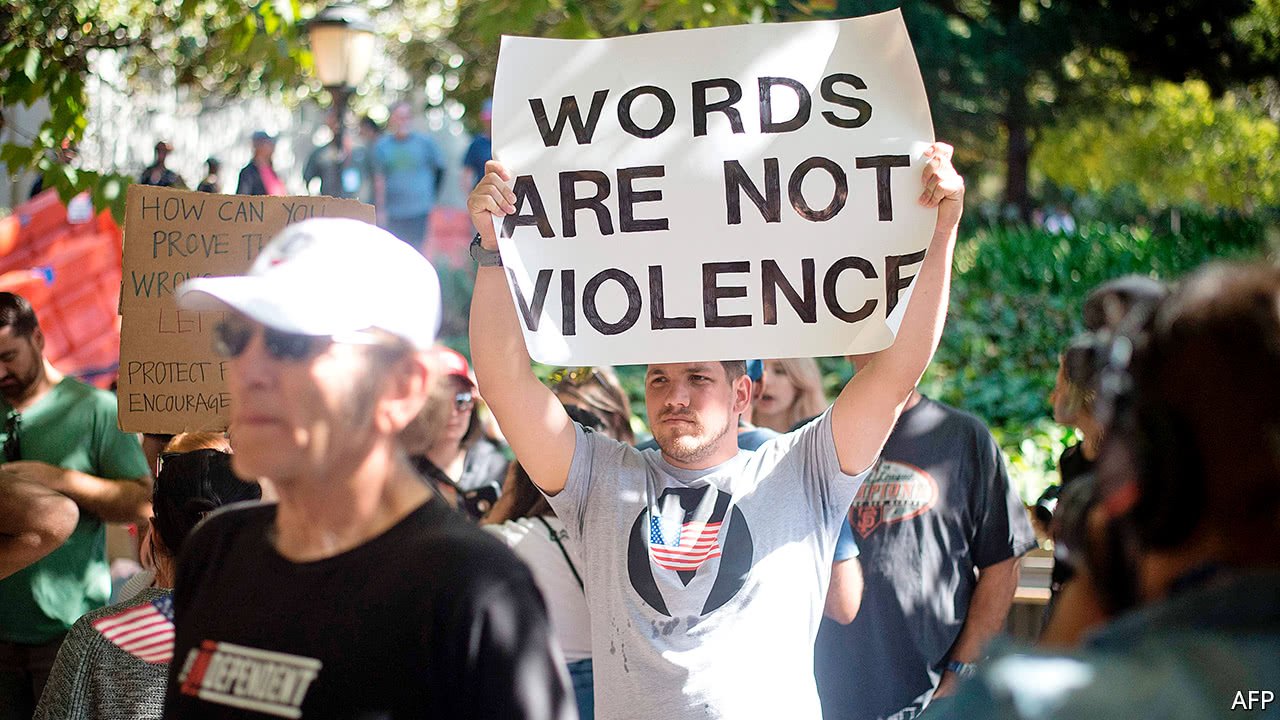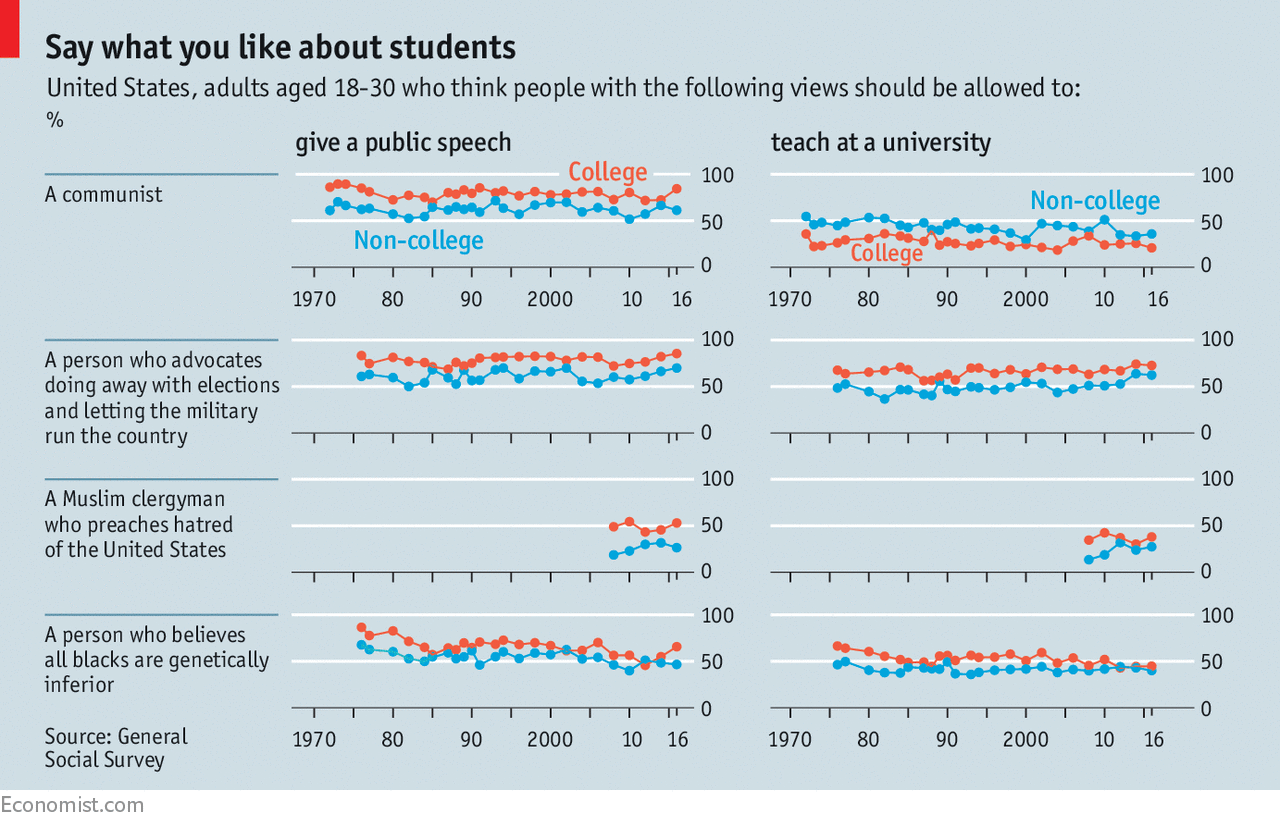隴山隴西郡
寧靜純我心 感得事物人 寫樸實清新. 閑書閑話養閑心,閑筆閑寫記閑人;人生無虞懂珍惜,以沫相濡字字真。|| 推薦到群組
The Economist: "no frame of reference” on free speech on campus?
Yep, it's right if you hit to "no frame of reference” on free speech and the importance of academic freedom - only within the boundary does freedom work. So, what's that boundary? Vague sometimes; clear some other time. How do you know such frame of reference?
Word got power. Don't play with flammable slogans, soundbites, - easy to set up a wild fire crossing board. Why?
So scared of freedom to speak? It's historical truth for students to initiate some great stuff, making history, changing human fate, altering path of progression. The key is "no violence" - the line in the sand, all of us should abide with, in th era of democracy - never mind revolution cliche, which is totally diffrent ball games with different frames of reference. Period.
**
Today's Stories
 | Free speech at American universities is under threatThe Economist - Oct. 12, 2017Howard Gillman, the chancellor of the University of California, gives students an annual pep talk on free speech. Students often come to university with “no frame of reference” on free speech and the importance of academic freedom, he says. [Subscription required, you can request an electronic copy .] |
The intolerant fifthFree speech at American universities is under threat
But fears of a pandemic of snowflakery are overwrought

“LIBERALISM is white supremacy!” shouted the students, as their hapless speaker—Claire Gastañaga of the American Civil Liberties Union (ACLU)—looked on. The protesters at the College of William and Mary, the alma mater of Thomas Jefferson, went further still. “The revolution will not uphold the constitution” they chanted on September 27th. “Nazis don’t deserve free speech”. The ACLU’s decision to defend the free-speech rights of white nationalists in Charlottesville, Virginia prompted the students’ ire. Because of it, Ms Gastañaga was unable to speak, and the event, called “Students and the First Amendment”, was cancelled.
Given their well-publicised antics, it is easy to see why college students can be tarred as blinkered devotees of political correctness run amok. Students at Oberlin, a liberal-arts college in Ohio, revolted over insufficiently authentic Asian cuisine, equating it to “cultural appropriation”. After the campus newspaper at Wesleyan University published an article critical of Black Lives Matter, students tried to defund the paper for failing to create a “safe space”. Elsewhere, students have launched campaigns against invited speakers, setting their targets on the likes of Joe Biden, Condoleezza Rice and Christine Lagarde. Together, this gives the alarming impression that a whole generation has rejected free speech. That impression is wrong.
Latest updates
Illiberal impulses can be found in many corners of society. But young Americans who have attended college are in fact more accommodating of controversial speakers, like avowed racists, than the general population is (see chart). Nor has tolerance of extreme views among students changed much in recent years according to the General Social Survey, which has been asking questions about attitudes to free speech for decades. Press reports, which understandably focuses on campus discord more than harmony, can create a misleadingly gloomy impression. While Charles Murray, a political scientist made radioactive by his writing on racial differences in intelligence, got into a violent scrape when speaking at Middlebury College, he emerged unscathed from recent talks at Harvard and Columbia.

The problem on campus, which nevertheless is a real one, is different. A survey of 3,000 college
students by Gallup for the Knight Foundation and the Newseum Institute finds that 78% favour campuses where offensive and biased speech is permitted. A separate study found that even at Yale, a
hotbed of student protest, 72% oppose codes that circumscribe speech, compared with 16% in favour.
Truly illiberal tendencies are limited to about 20% of college students. This is the fraction that thinks
it is acceptable to use violence to prevent a “very controversial speaker” from speaking, according to recent survey published by the Brookings Institution immediately after the violence in Charlottesville.
Though outnumbered, this vocal minority can have a chilling effect on what everyone else thinks
they can say. At Yale, 42% of students (and 71% of conservatives) say they feel uncomfortable giving
their opinions on politics, race, religion and gender. Self-censorship becomes more common as students progress through university: 61% of freshmen feel
comfortable gabbing about their views, but the same is true of just 56% of sophomores, 49% of juniors and 30% of seniors.
University administrators, whose job it is to promote harmony and diversity on campus, often find
the easiest way to do so is to placate the intolerant fifth. The two groups form an odd alliance. Contentious campus politics have been a constant feature of American life for more than 50 years. But
during the Free Speech Movement in the 1960s, students at Berkeley demonstrated to win the right to determine who could say what from administrators. Now the opposite is true. Student activists are demanding that administrators interfere with teaching, asking for mandatory ethnic-studies classes, the hiring of non-white or gay faculty and the ability to lodge complaints against professors for biased conduct in the classroom. This hands more power to administrators.
College administrators at public universities are subject to the full demands of America’s capacious First Amendment, which allows, among other things, hate speech and flag burning.
Federal courts have struck down every speech code enacted at a public university, and the Supreme
Court has declared academic freedom a “transcendent value” of “special concern to the First
Amendment”. Private universities are legally much freer to regulate the speech of their students and
affiliates. Many find themselves in an uncomfortable bind. University presidents want racially diverse
classes of students, all of whom feel welcome. Trustees and donors, sensitive to the critique of campuses as unthinkingly liberal, want intellectual diversity. Professors want to be left alone.
As principles go, free speech can also be expensive. Security at Berkeley for Ben Shapiro, a
conservative speaker, cost the university 1m. The university “hoped for the best but had to plan
for the worst”, says Janet Napolitano, the president of the University of California system (the
event was cancelled due to the incompetence of the organisers). People like Milo Yiannopoulos,
who seek out campus speaking gigs less out of a burning desire to say anything meaningful than in the hope of provoking a violent reaction, have worked out a formula for needling administrators. Mr Yiannopoulos has taken to asking student groups at Harvard for an invite, according to Conor
Healy, head of the Open Campus Initiative. Some of those currently standing up for free speech are trying to drain university resources while gaining personal notoriety. Berkeley is puzzling over how
to cap such spending, without penalising speakers with a particular set of views.
Many other colleges are trying to pre-empt the protests. Howard Gillman, the chancellor of the University of California, Irvine, gives students an annual pep talk on free speech. Students often come to university with “no frame of reference” on free speech and the importance of academic freedom, he says. The University of Chicago issued a firm statement, since adopted by other institutions which states that its role is not “to attempt to shield individuals from ideas and opinions they find unwelcome, disagreeable, or even deeply offensive”. A letter sent to the incoming class went further: “we do not support so-called ‘trigger warnings’, we do not cancel invited speakers because their topics might prove controversial, and we do not condone the creation of intellectual ‘safe spaces.’” There have been comparatively fewer clashes between activists and administrators at the university.
In fact, the share of schools with “severely restrictive” speech codes has declined for nine consecutive years, according to the Foundation for Individual Rights in Education, a pressure group. It is now a shade under 40%. The so-called Chicago principles have been adopted or endorsed by 31 other colleges and universities, including Princeton and Johns Hopkins. Purdue, a university in Indiana that was the first public institution to sign on to the Chicago principles, has taken a particularly vigorous approach to teaching students about free speech under the presidency of Mitch Daniels. Cultural-sensitivity trainings have been a mainstay of orientations at universities across the country, but Purdue now includes sessions promoting the value of free expression. “If these other schools choose to embarrass themselves by forcing conformity of thought, allowing diverse opinions to be shouted down or disinvited, that’s their problem,” says Purdue’s Mr Daniels. “However, if they’re raising up a generation of graduates with an upside-down version of our constitutional rights, that’s everybody’s problem.”
http://blog.sciencenet.cn/blog-847277-1080701.html
上一篇:academician(Yuan Shi): path to think in English




